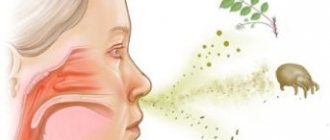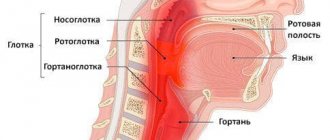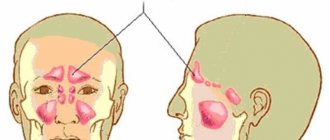Pain in the nasal cartilage is one of the common symptoms with which people come to see an otolaryngologist and traumatologist. After all, the most common causes of pain in the nasal cartilage are injuries and sinusitis. However, the problems can be much deeper and more serious. If you do not consult a doctor in a timely manner, complications may develop or inflammatory processes may begin. Today we will talk about the possible causes and treatment of pain in the nasal cartilage.
Pain in the nasal cartilage is in most cases accompanied by additional symptoms. Don’t forget to talk about them at your doctor’s appointment; this will help the specialist make an accurate diagnosis and find out why the nasal cartilage hurts.
One of the main symptoms is nosebleeds. It appears especially often in people suffering from hypertension, blood diseases, liver diseases, and those who have suffered various nasal injuries.
Often, a person who complains that the nasal cartilage hurts also notes an increase in temperature, headaches, and the appearance of a hematoma. In this case, a bruise is formed due to the accumulation of blood in the nasal septum. This can lead to complete destruction of the cartilage.
The cartilage of the nose also hurts when touched, the soft tissues swell, and respiratory function is impaired due to the blocking of the passages by damaged tissues and accumulated blood. Some victims notice that the nasal dorsum shifts.
Causes of pain in the nasal cartilage
Injuries are the most common cause of pain in the cartilage of the tip of the nose. They disrupt the natural functioning of the respiratory system, since the osteochondral plastic is displaced, damaged, and divided into 2 parts.
A fracture or bruise of the nasal cartilage and septum causes discomfort in the area of the nasal cartilage. As a result, swelling forms, breathing becomes difficult, blood may bleed, and suppuration develops. In this case, you should immediately contact a traumatologist. Otherwise, complications may arise; an abscess often forms when the nasal septum is deviated.
Pain in the nasal cartilage can also be caused by simple damage to the soft tissues of the nose. The reason for this may be an accident, a fight, or a fall. Athletes also often receive similar injuries during training and competitions.
However, pain in the nasal cartilage often appears not due to mechanical damage, but as a result of the development of sinusitis, rhinitis and other similar diseases.
Sinusitis is an accumulation of pus in the maxillary sinus, which causes pain in the nasal cartilage. Unpleasant sensations also appear in the forehead, teeth, head, and a general feeling of malaise is felt.
Rhinitis is characterized by inflammation of the nasal mucosa. It is accompanied by the following symptoms: nasal congestion and discharge, high fever, redness and watery eyes.
Tumors are another cause of nasal cartilage pain. However, their intensity is not expressed; in advanced cases, the nose begins to change its shape. In the initial stages, people experience difficulty breathing, bleeding and pus discharge.
The formation of boils, blackheads, and acne can also cause pain in the nasal cartilage. This happens because the soft tissues of the nose are covered with a large number of nerve endings.
Nasal cartilage hurts: treatment
If you have just suffered an injury that has damaged your nasal septum, apply a cold compress to the affected area as first aid. Use a cold water bottle, ice, or any cold object. Insert cotton swabs into your sinuses if there is heavy bleeding. Do not touch your nose under any circumstances if you have received a strong blow. Otherwise, the crushed hard tissues of the nose may become dislodged, spoiling the appearance.
Go to the emergency room or surgeon as soon as possible. The doctor must correct the nasal septum, performing the operation under local or general anesthesia. If you do not receive timely professional help, you may develop complications (chronic rhinitis, sinusitis), respiratory function may also be impaired, or the nasal septum may shift.
If you have nasal cartilage pain, we recommend that you consult a specialist. Only he will be able to accurately answer the question of why the nasal cartilage hurts after carrying out diagnostic procedures. The nose is a vital respiratory organ, so we advise you to monitor it and consult a doctor if any changes occur.
Pain in the nose, especially when accompanied by a runny nose, does not cause concern for anyone - a cold, what’s so scary about it? However, pain with nasal discharge can be symptoms of diseases that are much more serious and dangerous. Let's consider what could happen if, what to do in this case and which specialist to contact.
There may be several internal causes of pain in the nasal cartilage area:
Nose injuries
– bruise, violation of the integrity of the mucous membrane. In this case, the pain is acute and occurs immediately after a blow, fall and other similar situations;
– gives pain of great intensity, caused by the accumulation of contents in the maxillary sinus, when released, the pain subsides. The pain radiates to the forehead and teeth, intensifies at night and in the morning. May be accompanied by symptoms of a cold - high fever, chills, nasal congestion, runny nose. Signs of chronicity of the process are pain - tolerable, pressing, combined with headaches and malaise. Increased pain is provoked by fatigue, overheating, and physical activity;
In this case, the pain is caused by inflammation of the nasal mucosa and is of an unexpressed nature. More striking manifestations of the disease are nasal discharge, congestion, headaches, and there may be a high temperature. In the case of rhinitis of an allergic nature, the pain is also mild and occurs against the background of burning, itching, and nasal congestion. In addition, inhalation of an allergen (animal fur, dust, plant or flower pollen, etc.) leads to profuse nasal discharge, eyes watery and red;
Tumors
– some nasal tumors give an unexpressed pain syndrome, and are often accompanied by difficulty breathing, purulent discharge and spontaneous discharge. A growing tumor can also cause a deformed nose;
Charlin's syndrome
(nasociliary nerve) – you can think about this disease if your nose hurts more often at night, and the pain is paroxysmal in nature. Attacks can last from 10 minutes to several days. The pain during an attack is pressing, bursting, one-sided, and can radiate to the eye and forehead;
Inflammation of the pterygopalatine ganglion (ganglionitis)
– this disease is manifested by sharp, spontaneously occurring pain in the nose, eye area, and upper jaw. They can spread further - to the temples, back of the head, neck and shoulders.
Causes
The cause of unpleasant sensations in the nose when pressed can be trauma, allergies, neurological pathology or infectious inflammation of the epithelial and cartilaginous structures in the nasopharynx. Conventionally, all causes of pain in the nasal cavity can be divided into two categories:
- internal – neuritis, fractures, inflammation;
- external – burns, frostbite, bruises, boils.
According to practical observations, pain in the nasopharynx during palpation of the wings of the nose and bridge of the nose can be caused by:
Rhinitis
Rhinitis (runny nose) is an acute or sluggish inflammation of the nasopharyngeal mucosa caused by infectious or allergic agents. Diseases can be triggered by hypothermia, polluted air, hormonal and vasoconstrictor drugs, etc. In the acute course of a runny nose, foci of inflammation form in the mucous membrane, causing the nasopharynx to swell. Pressing on the tip and wings of the nose can cause discomfort in the turbinates and maxillary sinuses.
Chronic runny nose can trigger the development of sinusitis, in which inflammation occurs in one or more paranasal sinuses.
To eliminate pain inside the nasopharynx, it is necessary to reduce inflammation in the mucous membrane and restore the outflow of viscous secretions from the nasal passages and paranasal sinuses. As a rule, nasal drops with antiseptic and vasoconstrictor effects are used for this. Inadequate treatment leads to the development of atrophic or hypertrophic runny nose, in which discomfort in the nose appears even without physical pressure on the wings of the nose or the bridge of the nose.
Sinusitis
Sinusitis is inflammation of one or more paranasal sinuses. In most cases, the disease develops against the background of an infectious runny nose, allergic rhinitis and colds. Pathological changes in tissues are caused by pathogenic microbes and viruses.
Delayed treatment of sinusitis is fraught with the involvement of all paranasal sinuses in the inflammatory process and, as a consequence, the development of pansinusitis.
The main sign of the development of sinusitis is pain, which, when pressed on the tip of the nose, can radiate to the bridge of the nose, the orbital area of the face, the back of the head, etc. Clinical manifestations of sinusitis depend on the location of the lesions. With sinusitis, discomfort occurs at the level of the wings of the nose on the right and left side, with frontal sinusitis - in the bridge of the nose, with ethmoiditis - under the eyes, with sphenoiditis - inside the skull at the level of the nasal septum.
Herpes
Quite often, nasal pain occurs due to the development of herpes in the mucous membrane of the nasopharynx. As a rule, herpetic blisters form on the inner surface of the nasal canals, so when pressing on the wings of the nose, burning, itching and pain occur. The disease manifests itself in the event of a sharp decrease in the body’s immune defense, so the most likely causes of the formation of a rash in the nose include:
- hypothermia;
- hypovitaminosis;
- exacerbation of chronic diseases;
- iron deficiency anemia;
- injuries to the nasal mucosa.
Untimely relief of inflammatory processes is fraught with the spread of infection to the conjunctiva of the eyes.
Specific treatment for herpes infection is not required. To eliminate unwanted manifestations of the disease, it is enough to treat the inner surface of the nasal passages with zinc or tetracycline ointment.
Neurological diseases
A fairly rare cause of pain inside the nasal cavity is neurological disorders. Inflammation of individual nerves (neuritis) and nerve nodes (ganglionitis) is accompanied by paroxysmal pain, which can disturb the patient for from several minutes to days. The nature of the discomfort depends on the location of the inflammation. With neuritis, pain can radiate to:
- eye area;
- eyebrows; bridge of the nose;
- back of the head;
- gum;
- temple;
- forearm.
Pain in the cartilaginous part of the nose: what to do?
The only reason from the above for which most of us already know what to do if the nasal cartilage hurts against the background of discharge from it is rhinitis. In this case, we have a variety of ready-made medications and traditional medicine recipes at our service. Although an examination by a general practitioner will also not be superfluous. In all other cases, contacting a medical specialist (surgeon, neurologist or allergist) is mandatory.
The cause of pain in the nose, pain in the nasal cartilage is primarily mechanical damage to the nose. Absolutely all unpleasant sensations of a painful nature arise due to injuries to the nasal septum, as well as as a result of chronic diseases.
Mechanical injury to the nasal cartilage is characterized by displacement of the osteochondral plate. And this is what leads to the fact that a person periodically experiences painful sensations. The cartilage of the nose begins to hurt when the osteochondral plate is divided into two parts.
The cartilage of the nose hurts immediately at the time of injury to the nose, as a result of a fracture, after bruises. In addition to unpleasant sensations, a person may spontaneously bleed, experience difficulties with respiratory function, swelling, and pain.
If the mechanical injury was severe, then the occurrence of a deviated septum, the formation of suppuration, bruising, and tissue damage is not denied. If such injuries occur, then it is necessary to contact a traumatologist or surgeon to provide professional medical care. Otherwise, there is a risk of complications. As a rule, after injuries (bruises, fractures), an inflammatory process begins in a person.
A deviated nasal septum is a fertile ground for the formation of an abscess.
Causes of nose pain
The causes of nasal pain depend on which part of the nose was damaged. Anatomically, the nose consists of a nasal plate, cartilage, paired bones on the back of the nose, skin, soft tissue, as well as a perpendicular plate lining the nasal septum.
There are several causes of nasal cartilage pain:
- Injury to the nasal septum, and consequently pain in the cartilage;
- Mechanical damage to bone;
- Displaced fracture;
- Damage to soft tissues.
As a rule, mechanical damage to the nasal septum occurs as a result of participation in sports events, after road accidents, as well as as a result of impacts and injuries. During a blow to the bridge of the nose, a person may experience nausea, vomiting, and severe pain in the head. In some cases, this condition leads to fainting.
Causes of pain in the nasal cartilage
The causes of pain in the nasal cartilage are classified depending on the location of the pain. So, let's take a closer look at the external causes of nasal pain.
External causes of pain in the nose include the formation of purulent discharge, boils, blackheads, and acne in the nasal area. Since the soft tissues on the nose are covered with more nerve endings, the formation of even a small pimple can lead to pain in the nose.
If the boil begins to develop and swell, then the skin in the localization of the neoplasm changes, and pain appears in the nasal region. The discomfort goes away after the cause of the pain is eliminated.
Treatment
The treatment plan for eliminating perichondritis is prescribed by the attending physician individually for each patient, since treatment tactics may differ depending on the location of the inflamed cartilage.
Thus, treatment for perichondritis may include:
- surgical intervention aimed at removing the affected cartilage is indicated for damage to the ribs. After surgery, you will need to take antibiotics and painkillers. A similar treatment option is necessary for Tietze syndrome;
- opening of the abscess and physiotherapeutic procedures for damage to the outer ear. The most effective in the treatment of perichondritis of the auricle are UHF and microwave. The use of local remedies, for example, “Tizina” or “Nazivina” is also indicated;
- resection of the cartilage of the larynx - however, even after this, a deforming scar is formed, affecting the voice and making breathing difficult;
- drainage of an abscess in the nasal cavity - in order to partially preserve the nasal septum.
Treatment with lotions and compresses based on decoctions of medicinal herbs or plants, as well as a solution of boric acid, can be effective only if the outer ear or nasal septum is affected. In any case, such therapy should be agreed upon with the attending physician.
Internal causes of pain in the nasal cartilage
Internal causes of pain in the nasal cartilage are presented in the form of bruises, fractures, as well as mechanical injuries of the nose of a different nature, leading to damage to the mucous membranes. Also, as a result of internal reasons, a destructive process may begin, namely the destruction of nasal cartilage.
If a person has a pain in the nose without a specific etymology, then it may be rhinitis, sinusitis, as well as the formation of various tumors or inflammatory processes.
Symptoms of nasal pain
Symptoms of nasal pain include:
- Bleeding – especially in those who suffer from hypertension;
- Pathological blood diseases;
- Liver dysfunction;
- Mechanical curvature or deformation of cartilage.
Diagnosis of the disease
It is believed that the diagnosis of damage to the nasal septum and cartilage in particular is impaired due to the fact that blood penetrates into the soft affected tissues, is absorbed into the tissues, and as a result a hematoma is formed. Afterwards, there is a risk that a person will develop a purulent process.
In addition, the patient experiences a severe headache, unpleasant painful sensations in the nose, increased body temperature, bruising, and cartilage injury. All these phenomena occur because blood accumulates in the nasal septum, which causes the formation of a hematoma. Further, the nasal passages are blocked by damaged tissues and blood, and respiratory function is impaired.
If a person’s nasal wall collapses, then in addition to pain in the cartilage itself, the person will experience deformation of the nose and characteristic severe pain when touched.
Mechanical damage in the nasal area is diagnosed using so-called otolaryngological studies. And the first thing is an x-ray of the nose. The patient is sent for an x-ray of the nose in all cases if there are complaints of pain in the nose.
First aid[edit | edit code]
Stop bleeding
. In the vast majority of cases, with a fracture of the nasal bones, bleeding is more intense and prolonged than with milder injuries to the nose. In winter, it is usually much easier to completely stop or reduce bleeding than in summer. If a fracture of the nasal bones occurred outdoors in winter, then you should carefully apply snow or ice to the nose area and the bridge of the nose. This will prevent severe swelling and help stop or reduce nosebleeds. In summer, clothing such as a T-shirt can be used to stop or reduce nosebleeds. If your nose is broken, you should not lift your head too much; it is best to keep it slightly tilted to the side. It is possible that only doctors in a hospital or emergency room can completely stop nosebleeds.
Self-reduction
. You should not try to set the broken nasal bones back on your own or with outside unqualified help; this can only aggravate the situation and increase bleeding.
Treatment of nasal cartilage pain
As soon as a person has suffered an injury to the nasal tissues, it is necessary to first apply cold ice or make a cold compress. If a person experiences severe nosebleeds, then cotton wool pads are inserted into the nasal sinuses.
It is imperative that if pain occurs in the nasal cartilage, you need to seek help from a surgeon.
Any damage to the nasal septum, accompanied by bruises, fractures or other mechanical damage, always manifests itself in the form of pain.
You should not touch your nose if there was a strong blow. This can lead to the fact that a person, through careless handling, can dislodge the crushed hard tissues of the nose. Restoration of the nasal septum is a fairly common operation that is performed under local anesthesia.
Treatment[edit | edit code]
- Outpatient treatment - if the fracture is not severe, the doctor can perform initial treatment and release the patient for outpatient treatment. Physiotherapy and a course of antibiotics are prescribed.
- If a fracture occurs with the formation of bone fragments or with displacement, then they resort to repositioning the fracture (connecting bone fragments). Sometimes it is possible to set (set) the bones in place with two movements of the fingers. If there is retraction of the bone, a special tool is used - an elevator (elevatio - to raise)[8][9].
- For severe fractures, rhinoplasty is performed. If the nasal septum was also affected, they first resort to the septoplasty procedure, since a displaced septum will not allow the external nose to be fixed in the correct position. After surgery, a fixing plaster bandage is applied to the nose for 10-14 days.










